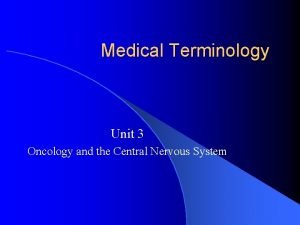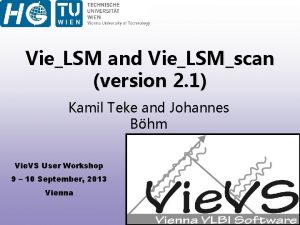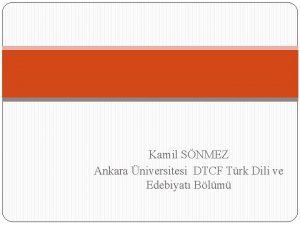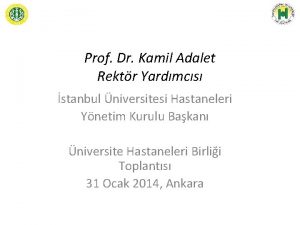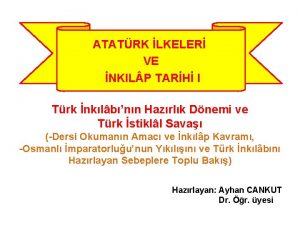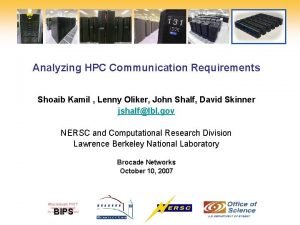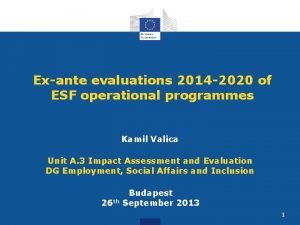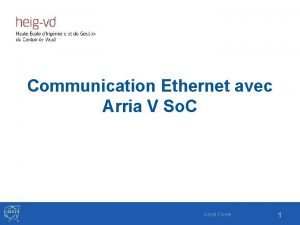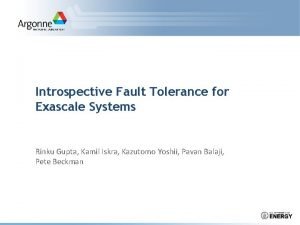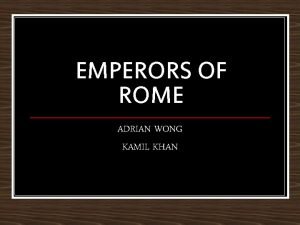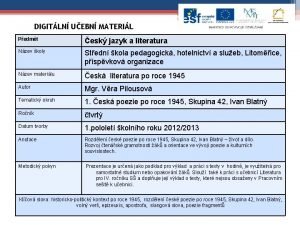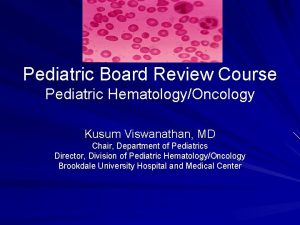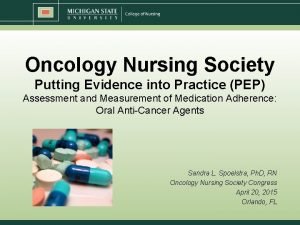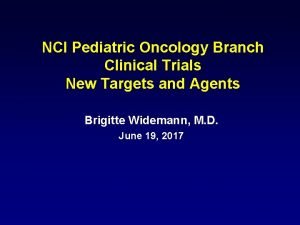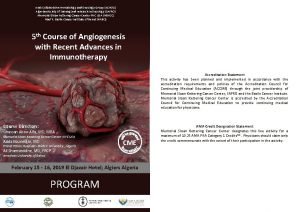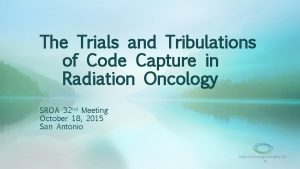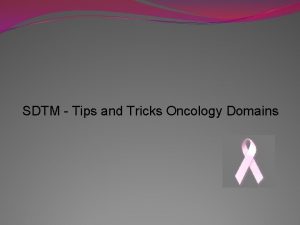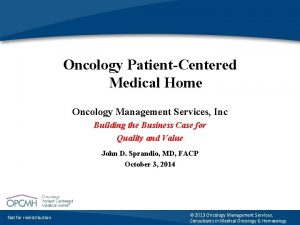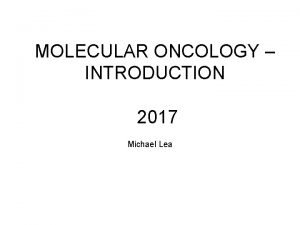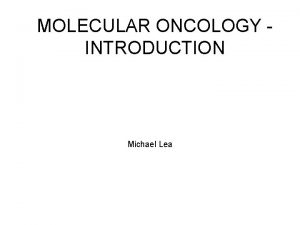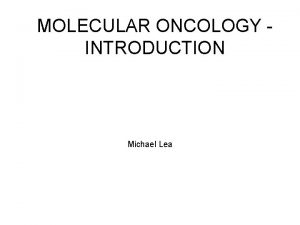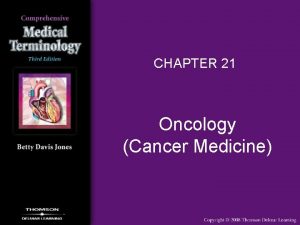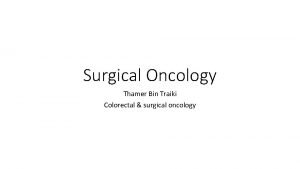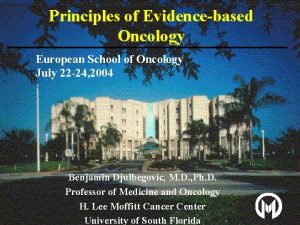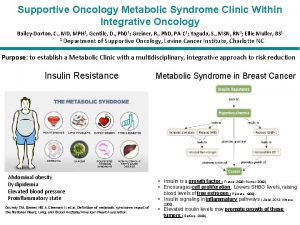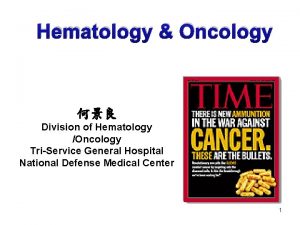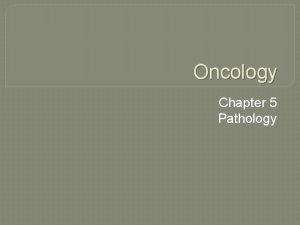Introduction to medical oncology Kamil Konopka MD Introduction



















































- Slides: 51

Introduction to medical oncology Kamil Konopka MD

Introduction Always ask Have: white coat, stethoscopes, students' ID with you Be on time Try to pick up practical things What is SAES? What are „rotations”? And what are they for Workshops? PBL Exam

Exercises Department of medical oncology, Śniadeckich 10 str, 2 nd floor Meeting point : registration Rotation

SAES The topics of these presentations should be chosen by students from the available list : 1. Bowel obstruction in cancer patients 2. VTE and cancer 3. Oncoemergency: increased intracranial pressure 4. Pericardial tamponade due to malignant pericardial effusion Students are asked to divide into 4 equal groups (per each SAES meeting) and prepare ppt. The time is 7 -10 minutes for presentation plus 1 -2 minutes for discussion/questions, which means no more than 12 slides (including ‘hello’ and ‘thank you’slide; Not only the presentation itself, but also the way it is presented are taken into consideration.

Workshops Chemotherapy related diarrhea Nephrotoxicity and bladder injury Chemotherapy induced nausea and vomiting Dermato-toxicity (Acne-like rash and secondary skin malignancy in cancer treatment) Immune-related adverse reaction

Radiotherapy Prokocim, Wielicka str. (University Children’s Hospital of Cracow ) Sala pod witrażem Lecture room under stained-glass

Exam Last day of course 50 single answer questions. Cowered in presentations

Principles of oncology

Principles Oncologist – a simple person 3 questions rule 1. Is it a cancer? 2. What type of cancer (WHERE is primary)? 3. What is the intention of treatment? When to stop/ why not to start the treatment?

Adenocarcioma Squamous cell carcinoma Type Sarcoma Lymphoma and leukemia etc



Histopathology Type of cancer define type of treatment Adenocarcinoma of esophagus ≠ Squamous cell cancer of esophagus Subtype not that important A bit obsolete


Staging Tumor Local invasion Adjacent tissue Nodes Metastases TNM staging system How big is it?

TNM T(umor) Size, depth of invasion etc N(odes) Only local/regional Number, size, localization M(etastases) Single, multiple

Grade II Grade III Grade IV How aggressive it is? A bit obsolete, but still important


Cancer What is our intention? Curative Palliative Our methods? Our aggressiveness?

Curative Localized solid tumors Oligometastases Extremely chemosensitive tumors Testicular cancer Some lymphomas and leukemia's

Palliative Stage IV solid tumors Locally advanced tumors When radical treatment of metastases is not feasible When radical treatment is not possible Patient in poor general condition not feasible for curative treatment

Cancer Palliative ≠ Palliative chemotherapy in colon cancer stage IV OS from 6 months to 2 -3 years Palliative care = hospice care

Cancer

Principles Explain the principles of treatment over your patient on every level of disease Evaluate the prognostic factors: tumor’s location, staging, grading, failure of primary treatment, length of time from the treatment to relapse, PS, nutrition Individualize plan of treatment Treat the patient not only the disease: coping with physical symptoms; identification of situations when secondary, negative effects are stronger; psychological support Radical and palliative treatment

Principles Patients treated at the comprehensive cancer center have considerably better survival than those treated in a local hospital! (Harding et al, 1993, Junior et al, 1994, Gillis et al, 1996)

Multidiscilinary team

Oncology Surgical oncology Radiation oncology Medical oncology

Medical oncology Not an „universal” speciality Medical oncology (drugs, PL, UK, FRA) Clinical oncology (drugs + radiotherapy, UK) Hematooncology (cancer + leukemia, Ger) Surgical oncology, gynecological oncology (drugs + surgery, PL)

Modalities Knife Beam Drug Goal? Eradicate all cancer cells Do not kill patients

Modalities Are all methods of treatment equal? Surgery> Radiotherapy> Systemic treatment

Drugs Chemotherapy Hormonotherapy Targeted treatment Immunotherapy TKI inhibitors Monoclonal antibodies etc

Subjective efficacy index Authors own reflection Not a true index Do not use it outside of this presentation Antibiotics = 10/10

Cytotoxic chemotherapy Old Cheap Toxic „Spearhead” treatment Subjective efficacy index =5/10 …. . Probably will not evolve too much…. Still a cornerstone

Hormonotherapy Old Cheap Safe „weapon only effective against special types of enemies” SIE 8/10 …only effective in small group of diseases… …probably will not evolve to much…

Targeted treatment Modern Expensive 100 k $ for ipilimumab 10 k $/month for vemurafenb „Sniper gun” SEI 6/10 …probably will evlove… …but not yet evolved…

Chemotherapy Curative Neoadjuvant, concurrent Testicular cancer, lymphomas To enhance efficacy, shrink tumor, decrease risk of recurrence Palliative To increase survival To maintain Qo. L To decrease symptoms of disease

Chemotherapy Is treatment successful RECIST (Response evaluation criteria in solid tumors) CR – complete response PR – partial response (>30%) SD- stable disease PD – progressive disease

DNR Do not resuscitate No such law in Poland „Persistant therapy”

Tumor markers Less useful than you may think Screening of healthy population – false/true Diagnosis of a malignancy – false Determining the prognosis – true Monitoring of patient during/ after treatment - true

Tumor markers Germinal tumors B-HCG , AFP, LDH Colon cancer > CEA , Ca 19 -9 Prostate ca > PSA Medullary thyroid cancer > calcitonin Ovarian cancer > Ca 125, HE 4 Pancreatic cancer > Ca 19 -9 Gastric cancer > Ca 19 -9, CEA Hepatocellular cancer > AFP Breast ca > Ca 15. 3

Definitions Prognostic factor Predictive factor

Definitions Factors Prognostic factor tells us about disease Predictive factor tells us about treatment

Definitions OS (overall survival) Time from diagnosis to death PFS (progression free survival) Time from initiation of treatment to progression or death 1 y, 3 y, 5 y-survival RR (response rate) RECIST PR+CR CTC AE (common toxicity criteria of adverse events)

CTC AE

CTC AE G 1, G 2 – mild G 3, G 4 – severe G 5 - fatal

PS (Zubrod scale) PS 0 – asymptomatic PS 1 – symptomatic, but in good condition PS 2 -<50% daytime in bed PS 3 ->50 of daytime in bed PS 4 – bedbound PS 5 - dead

Guidelines NCCN ESMO PUO

NCCN

NCCN


Thank you for your time
 Jessica konopka
Jessica konopka Jessica konopka
Jessica konopka Oncology meaning in medical terminology
Oncology meaning in medical terminology Dil izharı
Dil izharı Kamil sznajder
Kamil sznajder Kamil zięba umcs
Kamil zięba umcs Nizami gencevi kamil bir palanci
Nizami gencevi kamil bir palanci Ssm wisła płock plan treningowy
Ssm wisła płock plan treningowy Wan abdul rahim kamil
Wan abdul rahim kamil Kamil teke
Kamil teke Translanguaging for dummies
Translanguaging for dummies Kamil wasilewski internet
Kamil wasilewski internet Hyperechogénny
Hyperechogénny Yeniden sevedebilirim
Yeniden sevedebilirim Horehronie rozbor piesne
Horehronie rozbor piesne Kronospan foundation
Kronospan foundation Kamil nejezchleb
Kamil nejezchleb Prof dr kamil adalet
Prof dr kamil adalet Kamil szatkowski
Kamil szatkowski Arapça kamil olma olgunlaşma
Arapça kamil olma olgunlaşma Tmmkm
Tmmkm Kamil toman
Kamil toman Shoaib kamil
Shoaib kamil Kamil valica
Kamil valica Kamil florek
Kamil florek Kamil kucera wikipedia
Kamil kucera wikipedia Kamil szadkowski srednia
Kamil szadkowski srednia Grecki bóg ognia i złotników
Grecki bóg ognia i złotników Kamil gupta
Kamil gupta Kamil krysztofiak
Kamil krysztofiak Kamil majestic age
Kamil majestic age Kamil lhoták
Kamil lhoták California medical license application
California medical license application Greater baltimore medical center medical records
Greater baltimore medical center medical records Hepburn osteometric board
Hepburn osteometric board Torrance memorial transitional care unit
Torrance memorial transitional care unit Cartersville medical center medical records
Cartersville medical center medical records Unc hematology oncology
Unc hematology oncology Sachs immuno oncology bd&l and investment forum
Sachs immuno oncology bd&l and investment forum Steelhead oncology
Steelhead oncology Pediatric board review courses
Pediatric board review courses Oncology haematology helpline triage tool
Oncology haematology helpline triage tool Ons pep
Ons pep Nf1pn
Nf1pn Ukons triage tool version 3
Ukons triage tool version 3 Rs domain sdtm
Rs domain sdtm Lucy langer md compass oncology
Lucy langer md compass oncology Dr raymond wynn radiation oncology
Dr raymond wynn radiation oncology Premier oncology hematology management society
Premier oncology hematology management society Bogardus radiation oncology billing
Bogardus radiation oncology billing Nrg oncology meeting 2018
Nrg oncology meeting 2018 Cdisc oncology domains
Cdisc oncology domains


